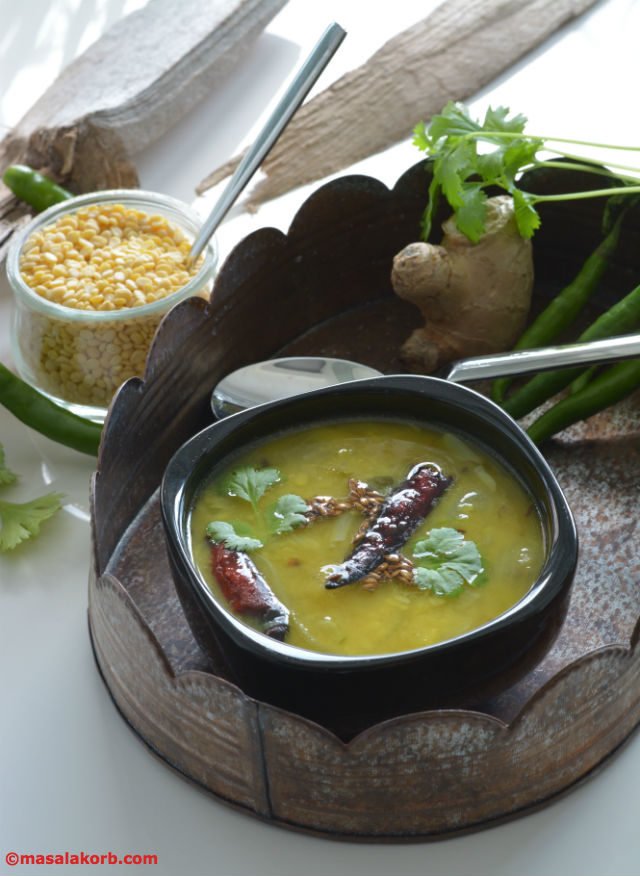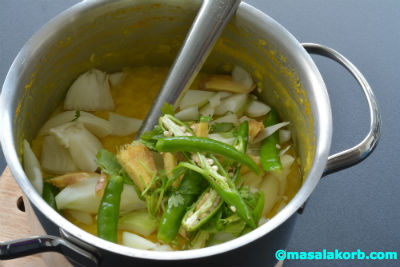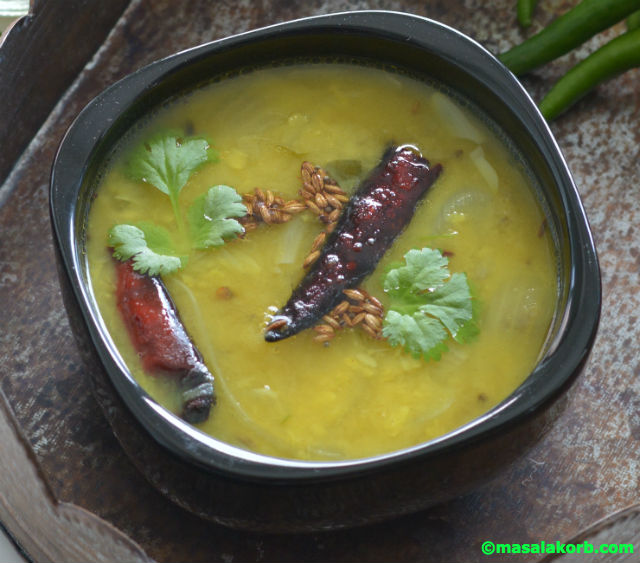 Hi everybody!!…Today I’m going to share Moong dal rasam or Pesara pappu charu as a part of our Blog hop theme “RASAM RECIPES”. But before getting into the recipe, I would like to share some history of rasam. Thanks to blogging, which gives us an opportunity to go deep into the subject and do some research to expand our knowledge and provide some valuable information to my lovely readers. Not interested??…..No problem, then scroll down directly to the recipe!!
Hi everybody!!…Today I’m going to share Moong dal rasam or Pesara pappu charu as a part of our Blog hop theme “RASAM RECIPES”. But before getting into the recipe, I would like to share some history of rasam. Thanks to blogging, which gives us an opportunity to go deep into the subject and do some research to expand our knowledge and provide some valuable information to my lovely readers. Not interested??…..No problem, then scroll down directly to the recipe!!
Rasam, chaaru, saaru or kabir is a South Indian soup, traditionally prepared using tamarind juice as a base, with the addition of tomato, chili pepper, pepper, cumin and other spices as seasonings. Steamed lentils are also sometimes added along with any preferred vegetables. Nowadays, all the seasonings required are combined and ground beforehand into rasam powder, which is readily available in the market. In addition to that, like Iced Tea and Cold Coffee, Rasam is also marketed commercially as Chilled Rasam. This is something totally new to me, but I would always prefer freshly made rasam![]() .
.
It is eaten with rice or separately as a spicy soup. Rasam has a distinct taste in comparison to the sambar due to its own seasoning ingredients and is usually fluid in consistency.
In Sanskrit language, ‘Rasa’ means Juice. It can refer to any juice but in Tamil simply rasam commonly referred to the one prepared with Tamarind/Tomato juice with added spices. Saaru in Kannada language or Chaaru, in Telugu language, means “essence,” and, by extension, “juice” or “soup”. Historically, it was prepared mainly with black pepper and tamarind, both ingredients native to and abundant in South India in general. It is also referred to as SatruAmudhu…or even known as South Indian soup.
Sourashtras, an immigrant community living in Madurai from the 16th century, still refer to it as Pulichaar (Puli or Pulipu means sour or tart (tamarind). Rasam is the basis of the Anglo-Indian Mulligatawny soup. This is only corrupted version of a Tamil word ‘Milagu-t-tannir’ meaning pepper water (In Tamil milagu means black pepper and tannir means water). It is said that Netaji Subhas Chandra Bose once commented that if he had command over the country, he would have declared Rasam a national drink.
Something learnt, Isn’t it? Thanks to wiki for making the job easy![]() .
.
Source: Wikipedia
Why rasam? How did it evolve? We have to ask the experts who turned leftover ingredients to a mouthwatering recipe. Soaking excess tamarind for sambar or curry and turning the left over tamarind extract into an appetizing rasam. When some excess water is added to cooked dal, the left out dal water turns into lip-smacking rasam. It is so popular everyday recipe and also the staple food combined with rice, especially when someone is suffering a cold or sick at home. Click here to have the recipe for the classic Pepper rasam.
All said about traditional rasam, there are so many variations you could be creative with. Today’s recipe neither has pepper nor tamarind. Moong dal rasam or Pesara pappu charu is a very delicious and comforting dal rasam, best enjoyed during summers since it keeps the body cool.
Whenever in doubt, grab moong dal is my “cooking motto”. You can always dress up its simplicity by any add-ons you can think of. I sometimes add vegetables to it, change my tempering, play with the seasoning. And every little tweak adds a new dimension to this otherwise kind-of-bland lentil. Moong dal is a great source of complex carbohydrates, fibre and protein. Regular consumption of moong dal helps to reduce cholesterol.
Among all the various dals or lentils, the split yellow moong dal or pesara pappu is most easy to cook without soaking and easy to digest. In fact the most important food for a light diet according to our ancient medical science Ayurveda is this moong dal and is recommended for children and the elderly as it’s easily digested. Well, if you are down with a stomach problem you would prefer to eat this dal as it’s very gentle on the stomach.
The tempering/seasoning is the most important part of this golden yellow dal, which gives it the perfect flavour and enhances its aroma is further with the usage of ghee. This dal is infused with turmeric, which provides a warm flavour other than imparting a golden colour while cumin, ginger, asafoetida, red and green chilli peppers aid in digestion of dal, thus, transforming this dish into a truly tantilizing everyday Indian dal if you make it thick and rasam, when it is runny.
Wow!! What a flavourful rasam with a great aromatic finishing touch with lemon. Off to the recipe!!
Step-by-Step process in making Moong dal rasam or Pesara Pappu Charu:
You will need:
- Slice onion lengthwise, slit green chillies, roughly chop or grate ginger and finely chop coriander.
- You can grate ginger if you like to eat it, otherwise cut into big pieces so that you can easily find them while eating and discard.
- Wash moong dal under running water 2 to 3 times.
- Add to 3 cups of water and turmeric to the washed moong dal in a vessel.
- Place the vessel with dal over medium heat and cook the dal completely. This takes about 10 to 12 minutes.
- Mash the dal well and add all the chopped ingredients (Onion, green chillies, ginger and coriander) and curry leaves to the dal.
- Add required salt and mix well.
- Now add enough water to get the consistency you desire to have.
- Boil the contents again over medium heat until onions cook completely. If you feel the consistency is too thick, add some more water. Turn off the heat when rasam boils. It takes about 5 to 8 minutes.
- For the tempering: Heat oil in a small pan over medium heat. Add mustard seeds, cumin seeds and dry red chillies. Once the mustard seeds begin to splutter, add a pinch of asafoetida and curry leaves and turn off the heat.
- Transfer the tempering into the moong dal rasam or peasara pappu charu.
- Allow it to cool and just before serving, add a dash of lime and serve with steamed rice or rotis or enjoy it as a soup. (If you wish to have it as a hot soup add an extra cup of water).
- If the consistency is thicker, you can also use it as sambar.
NOTE: Do not add lemon juice while hot, otherwise the rasam becomes bitter and also adjust salt after adding lemon juice.
Moong Dal Rasam Or Pesara Pappu Charu
Ingredients
- 1 cup split green gram or moong dal pesara pappu/Pasi payir
- 6 Cups water divided (to cook dal and dilute later)
- ½ teaspoon turmeric
- 1 Onion thinly sliced
- 4 to 5 green chillies slit length wise
- 1 inch ginger grated or cut into tiny chunks
- 2 tablespoons coriander finely chopped
- A sprig of curry leaves
- Required salt
- 1 to 2 Tablespoon lemon juice add at the end
- For the Tempering:
- 1 teaspoon mustard seeds
- 1 teaspoon cumin seeds
- 2 to 3 dry red chillis
- A big pinch of asafoetida
- Few curry leaves
Instructions
- Wash moong dal under running water 2 to 3 times.
- Add to 3 cups of water and turmeric to the washed moong dal in a vessel.
- Cook over medium heat until the dal is completely done.
- Mash dal well and add onions, green chillies, ginger, coriander and curry leaves.
- Now add required water to get the required consistency. Add required salt and mix well.
- Boil the contents till the onions are cooked. If you feel the consistency is too thick, add some more water and let it boil. Turn off the heat when onions are cooked.
- For the tempering: Heat oil in a small pan over medium heat. Add mustard seeds, cumin seeds and dry red chillies. Once the mustard seeds begin to splutter, add a pinch of asafoetida, curry leaves and turn off the heat. Transfer the tempering into the moong dal rasam.
- Let it cool and add sufficient lemon juice to suit your taste.
Notes
2. Do not add lemon when rasam is hot (warm is fine), it gives a bitter taste to the rasam. And also do not reheat once you add lemon. Best way is to add lemon before serving.
3. If you do not like to get a bite of ginger while eating, cut into big chunks so that you can remove it while eating.
4. You can decide how crunchy you want your onions to be cooked so boil accordingly.
5. You can include any vegetables or greens to this basic recipe. Spinach is a great combination.
6. Do not forget to adjust salt after adding lemon juice.
You might want to check out other popular posts in the similar category from my blog-
And many more to come!!….Stay Tuned!!
Happy Cooking:)
Padma















